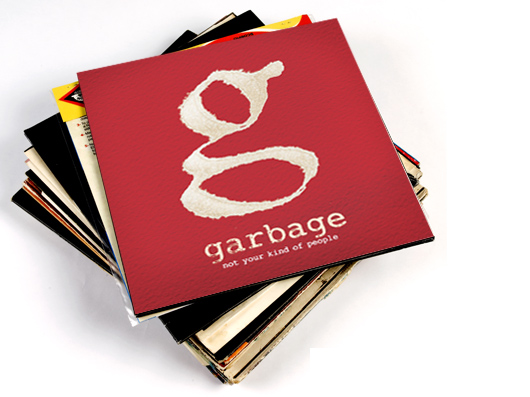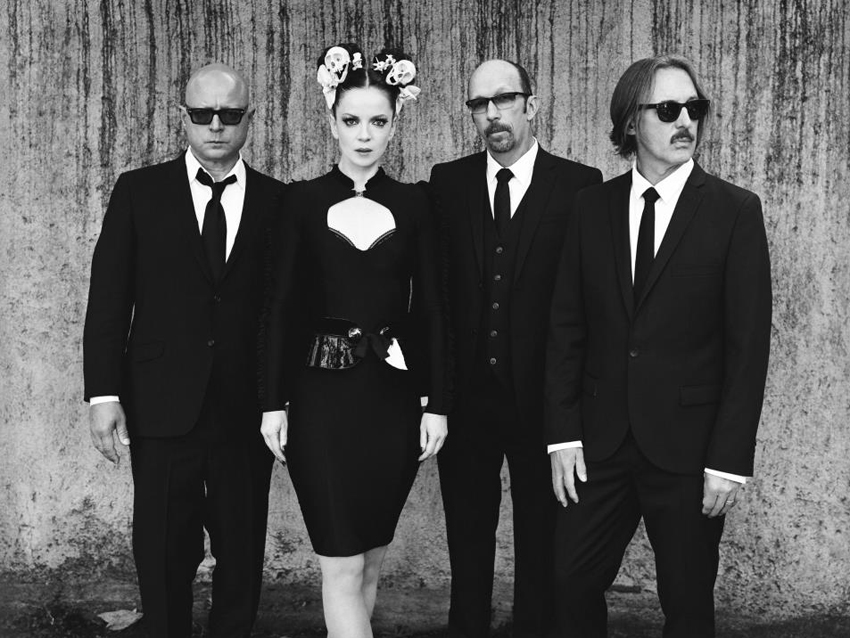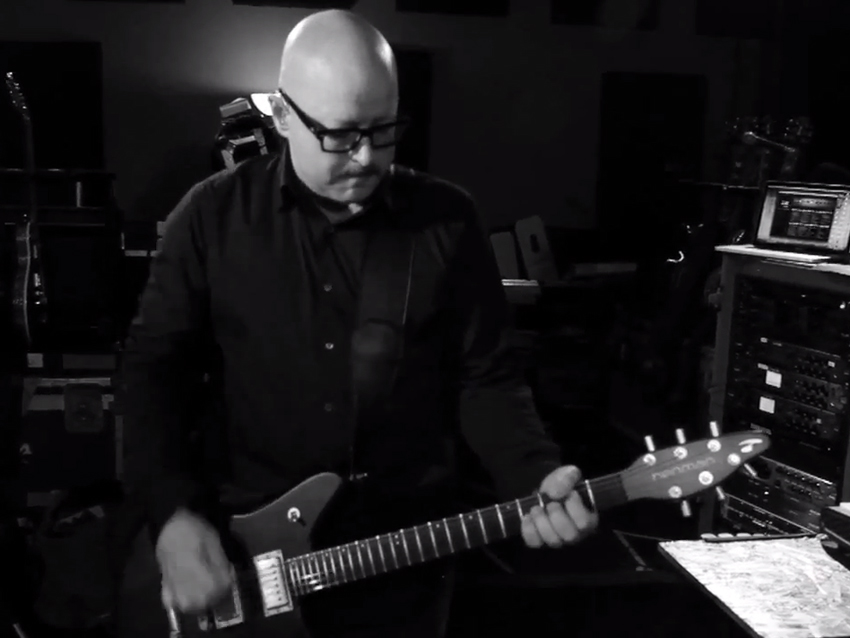
Interview: Garbage talk Not Your Kind Of People track-by-track
"We really made a conscious effort to make a cohesive record," says drummer Butch Vig of Garbage's stunning new album Not Your Kind Of People. "We're kind of old school in that regard. But it's funny – when we started writing, we didn't know if we were going to make an album; we were just writing. When we got to 21 or 22 songs, though, we started to realize that a lot of them would work well together. And that's good, because I still like putting on an album and listening to it from beginning to end."
When the members of Garbage – which also includes guitarists/bassists Steve Marker and Duke Erikson, along with singer Shirley Manson – got together in Los Angeles in mid-2010, they were coming off an extended hiatus. According to Marker, it didn't take long for the band to hit their stride. "The creative sparks started flying right away," he says. "I don't know if I knew how much I missed the band when we weren't working, but once we got together, it was like, 'Holy shit! Why did we wait so long?'"
Erikson echoes Marker's sentiments: "Just seeing that we could still do it was one of the best things to come out of this," he says. "In the first few days, we ran a lot of things up the flagpole, and all four of us saluted. That was very heartening. The minute we sensed that it was going to be all right was pretty cool."
Erikson and Marker continued their habit of trading bass and guitar duties, and a spirit of experimentation attended their tracking sessions, sometimes with comical results. “There was one time when I was playing a guitar part, and I wanted the sound to be more distortion than guitar," says Erikson. "We tried one pedal that started breaking up in this real irregular way. It was very chaotic and random, and it was exactly what I was looking for. I asked our engineer, Billy Bush, about the pedal, why it sounded so cool, and he said, ‘It’s because the battery’s almost dead.’”
The band recorded upwards of 26 songs, whittling them down to the 11 that comprise Not Your Kind Of People. Vig says that he expects to release many of the remaining cuts, possibly by the end of this year. As for another studio album – count on it. “We’re definitely going to make another record," he says, "and we won’t wait six years again. If we do that, we’ll all be in wheelchairs!"
On the following pages, Vig, Erikson and Marker walk us through the remarkable Not Your Kind Of People track-by-track.

Automatic Systematic Habit
“The song started out an a little jam called Electro," says Vig. "I programmed a synth progression over a drumbeat at home and brought it in. Everybody loved it. Shirley came up with some lyrics and started singing in this faux German accent. We were like, ‘OK, it’s really cool, but maybe you should lose the German accent.’ We laughed about it, though, and the point is that she heard something very Krautrock, a little techno. We walked around the studio mimicking the singer from Rammstein.
“Initially, the song was very electronic, but after Shirl did her final vocals, we toughened the track up. We changed the chords from major to minor, and Steve came up with that New Order-type riff – I think he did it on a bass.
“Shirl did a vocal on the bridge, and we liked that idea so much that we used it for the intro; we wrote a part that’s almost prog rock, kind of like Cream’s White Room. As soon as we did that, we said, ‘Oh, this should start the record – it’s so huge!’"
Listen - Automatic Systematic Habit

Big Bright World
“It came about because I couldn’t sleep for a couple of nights," says Marker. "I was staying at this really loud apartment in Hollywood, and I got up early one morning in a somewhat psychotic state – and the song was just there.
“I had Pro Tools on my laptop, so I grabbed an acoustic guitar and banged it out really fast – not the whole thing, but the gist of it. I e-mailed it to everybody else and went back to sleep. It all happened within the space of 20 minutes.
“Everything gets changed once we get into the studio. Butch had the idea to make the intro verse a little like the New York band Suicide, using some cheap keyboards. Then it goes into a big guitar thing – that all happened with the four of us together in the studio. For lyrics, I just had a couple of lines; Shirley ran with it and fleshed it all out.
“There’s some really weird guitars that sound almost like keyboards. I did some of those at home with a Guild Bluesbird. I’m playing slide – using a lot of compression it gets a real synth sound. We have some normal-sounding guitars, too, some Teles that we played in the studio.”

Blood For Poppies
Initially, it started out almost as a dub," says Vig. "It was a very simple groove and bassline, and then, as Shirl came up with this stream-of-consciousness vocal approach, the song kept getting refined. It was long verses at first. Once she did the chorus vocals, we came up with the fuzzed-out, saturated guitars.
“Steve plays the wah-wah part, and Duke does all the little melodic bits in the verses. Steve wrote the monster riff, almost at the 11th hour. Once he had the riff, we mixed the song, saturating everything, running it all through buses with distortion preamps.
“Shirl said that she was inspired by reading an article in the New York Times about the Afghanistan war, but she said that the song is also a metaphor for being in a band, feeling isolated and lonely. There’s the line ‘I miss my dog, I miss my freedom,’ and that’s her dog Vila she’s singing about.
“We wanted it to be the first single because it encapsulates so much about Garbage. It’s got the fuzzy guitars, and Shirley’s vocals are so great. We felt that if this was the first thing that people heard from us in seven years, then this was the perfect track. It’s uneasy, like you’re in a constant state of paranoia.”
Listen - Blood For Poppies

Control
“Butch brought this in," says Erikson. "He had the verse and chorus, and he already had the harp idea. Everybody liked it. It sounded like it could have a lot of impact. Basically, we tried to inject a lot of power into the song.
“I came up with the bridge idea, and all four of us chimed in on that. We wanted to make the last chorus totally chaotic, so I opened up the gate and ran a pulse through it. The whole song sounded like it was out of control.
“I think I played a Tele on the verses and a Strat on the second chorus. There may have been an SG involved. The template for the song was When The Levee Breaks. We did kind of a funked up take on that. It was even bigger sounding at one point, but the rhythmic pattern was getting lost, so we brought it back a notch or two.”

Not Your Kind Of People
“Butch came up with the line when he was driving around Los Angeles and saw some of the more unusual types of human kind out there," says Marker. "He called up Shirley with the title, and she said, ‘Yeah, that has to be a song.’ Rather quickly, we decided it had to be the title of the album because it summed up how we were feeling.
“Like so many songs, this one happened fast. Butch had the line, and we just grabbed the guitars and wrote it. Shirley’s vocals, too – I wouldn’t call them ad-libbed, but the words came together quick.
“I’m playing the intro guitar part. It was a kind of heavy metal riff when Butch brought it in, something he was playing around with, sort of Black Sabbath-like, but we put a clean, twangy, country-ish sound to it. There’s a lot of guitars on the track. I’m doing the slide stuff in the middle; it’s supposed to sound a little Pink Floyd/David Gilmour. I used a Henman guitar. I’ve been playing those live and having a lot of luck with them.”

Felt
“Felt is our shoegazer song on the album," says Vig. "We’re massive My Bloody Valentine and Jesus And Mary Chain fans, so this is a little nod to that British sound. I’m a pretty average guitar player – I’m not very good – and when I wrote the riff at home, the guitar was tuned weird. I don’t even know what it was. I made a little 30-second mp3 and sent it to everybody, and Shirley called me back: ‘I love it! I’ve got some lyrics to it.
“The next day, Duke, Steve and I had to quickly put a track together. The drum and guitar parts are pretty simple, but they’re dense – I think Duke and Steve layered about four or five tracks each. We definitely wanted to go for a British wall of sound feel – Phil Spector meets My Bloody Valentine.
“When those guys go about doing the guitars, it’s a bit of experimentation and trial and error. Whoever gets inspired first will pick up on something. Usually, they try to establish a core sound, something rhythmic, but they do like to come up with riffy things, weird things. They’ll fuck around for hours, plugging in different pedals and trying stuff out. There were something like 40 guitar tracks recorded for the song, but in the final mix we kept eight or ten.
“Shirl sang very softly. When we recorded her, she wanted a lot of reverb. ‘Mix me kind of low,’ she said. ‘I don’t want to hear what I’m singing.’ It’s a real fuzzed-out dream state. We haven’t played the song live yet, but we’ve rehearsed it and it sounds awesome. This is going to be a stomper when we play it in concert.”

I Hate Love
“I Hate Love started out as a ballad," says Erikson. "I think Butch and Shirley put their heads together and brought it in, and then we rewrote the chorus chords a bit and reworked the arrangement. For a time, it was a slow, moody ballad – and could still serve as that – but we decided that the album had too many slow songs, so we sped it up.
“When we do guitars, it’s kind of an ‘anything goes’ situation. Billy Bush has three walls of guitars, and we just go in and try to pick which one might have the right sound. So we don’t always think, ‘Gee, I’m playing a Telecaster here.’ We’re more concerned about the sound.”

Sugar
“I had come up with an idea on acoustic guitar, very simple," says Erikson, "so I recorded it with a little rhythm track, did the first verse and basically the arrangement for the song. Shirley loved it and immediately started singing – I think she must had had some words already written.
“Originally, I had a straighter rhythm, but we started messing around with a dubby kind of irregular pattern. I played drums on the song – I cut them at Smart Studios in Madison. Mike Zirkel, the engineer there, got me set up, I played some stuff, and we picked what worked. The drums aren’t very prominent, but they serve their purpose.
“The song could still work as a straight-ahead acoustic samba. But as it happens with all our tunes, we stretched it out and looked for as many sounds as we could, without harming the song. It’s easy with experimentation to lose the song, so we try to be aware of that.”

Battle In Me
“This song happened on either the first or second day that we got together," says Marker. "We were just trying to see if this whole thing would work. We had a rule that nobody could bring in any demos or old ideas; we were just going to set up in a studio and jam. Battle In Me resulted from that. The jam was probably 20 minutes on the hard drive. Each of us took it home and messed with it to make it the song that’s on the album.
“The night before, I had watched the movie It Might Get Loud, and I was feeling pretty fired up – there’s a little Jimmy Page in the song. Duke and I try to have no egos about what we do. We switch back and forth between guitar and bass. Sometimes somebody will be playing a part and maybe not quite getting it, so he’ll hand it to the other guy: ‘Here, you do it.’ We don’t really have guitar ‘leads’ per se, but there’s a lot of parts that weave together. From playing together for so long, we’re able to work pretty easily like that.
“I used the Henman again and put it through a Mojave amp – it’s sort of a re-creation of the early Marshall tube amps – and just a 2 x 12 cabinet. I was pretty inspired by the sound.”
Listen - Battle In Me

Man On A Wire
“I did the intro riff at home," says Marker. "It was something that just popped into my head, so I ran upstairs and got it down fast with a Strat and a Line 6 Pod. Funnily enough, it sat around for a long time. Everybody was going, ‘That’s a great riff. We’ve got to use it,’ but nobody knew what to do with it.
“Butch and Shirley had worked up the verses in the context of another song, and then somebody had the idea to put them together with this riff, and it worked out great.
“The riff you hear on the record is the same one I did at home in something like five minutes. I had recorded it with the basic drumbeat, which is some dumb drum machine I had, and I e-mailed it to everybody. Then my hard drive died and I couldn’t re-create the sound, so we used the stereo mix of my guitar with the drum machine on one track. Butch had the unenviable task of trying to hide my crappy drum sound. But it all worked out.
“I really love Shirley’s vocal, the way she channels Patti Smith. The words are all hers. If we didn’t have such a great front person, none of this stuff would work. She used to – like we all did – worry about stuff and belabor things past the point where it would do anybody any good. I think she works more off the cuff now, more immediate. It gives everything a fresh feeling.”

Beloved Freak
“Steve brought this in to the band," says Vig. "He had found this Klaus Nomi song – I think it was called Unfinished Opera – and he played some piano chords around it. If you soloed the Klaus Nomi sample, it’s not at all the way the track is. It’s very tricky the way we made the sample work in the context of the chords.
“We layered some more opera bits over it. I think Shirley added some vocal effects to try and gel the whole thing together. It’s very amorphous and floaty; it almost sounds like you’re drifting and falling off a ledge when Klaus’ vocal comes in.
“At first, the sample was very dominant, but as the track developed, we realized that the song had to be a song, so the sample started to take more of a backseat; we used it more as color. I think it’s an absolutely gorgeous song. I always love it when Shirley sings soft. When her voice is quiet, it’s more intense than when she sings hard.
“We kind of sensed that it would work as an album closer. It has the same sort of theme as Not Your Kind Of People. It’s kind of about being an outsider, a freak, and coming to terms that it’s OK to be different. We’ve always thought that way as a band, that we didn’t really fit in. Since that’s one of the big themes on the record, so it felt right to finish on that note.”

Joe is a freelance journalist who has, over the past few decades, interviewed hundreds of guitarists for Guitar World, Guitar Player, MusicRadar and Classic Rock. He is also a former editor of Guitar World, contributing writer for Guitar Aficionado and VP of A&R for Island Records. He’s an enthusiastic guitarist, but he’s nowhere near the likes of the people he interviews. Surprisingly, his skills are more suited to the drums. If you need a drummer for your Beatles tribute band, look him up.
"Reggae is more freeform than the blues. But more important, reggae is for everyone": Bob Marley and the Wailers' Catch a Fire, track-by-track
“Part of a beautiful American tradition”: A music theory expert explains the country roots of Beyoncé’s Texas Hold ‘Em, and why it also owes a debt to the blues
"Reggae is more freeform than the blues. But more important, reggae is for everyone": Bob Marley and the Wailers' Catch a Fire, track-by-track
“Part of a beautiful American tradition”: A music theory expert explains the country roots of Beyoncé’s Texas Hold ‘Em, and why it also owes a debt to the blues









